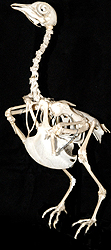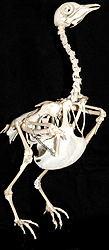
Introduction This program is designed to be used by archeologists, biologists and forensic scientists. Identifying bird bones to species is a labour intensive process. This program was created as a time saving tool to help identify bird bones to species. This program is a "guide" and is intended to be used with a comparative faunal collection. The program works on the simple concept of sorting out the long bones by their total length, combined with a visual aid using photographic images. Comparing the diversity of characteristics of the different bones in the images will narrow down the bone to a species or at least the possibility of two or three species. Having narrowed down the possibilities one can go to a comparative faunal collection for verification and final identification. Sex may also be determined for some species. This program also provides ranges of end widths to help narrow down the identification of species when only the ends of bones are present. Only the Falconiformes and Strigiformes of British Columbia are represented at this point. Work is continuing on other non-passerine species. Only non-passerine species will be considered. Subspecies and regional differences have not been segregated in this project. It has been found that taking measurements from x-rays will also work in this program. For more information please see FAQ's.
|
Copyright © Royal BC Museum. All rights reserved. | Privacy Policy | Copyright Policy |


